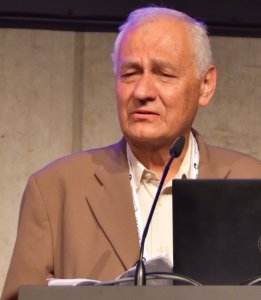IASPEI Medal Winner

IASPEI Medal winner 2023 - Harsh K. Gupta
Laudation
Prof. Harsh K. Gupta is best known for his work on reservoir-induced seismicity (RIS), which began with a detailed field investigation and study of worldwide seismograms following the M 6.3 earthquake at Koyna, India, in 1967. In the following decades, Harsh was instrumental in initiating several efforts to understand better how RIS differs from typical earthquake sequences and how to mitigate the effects of future events, including manipulating reservoir water levels. However, a model to explain RIS remained elusive for him. It was not until 2011 – 2016 that under Harsh’s leadership, a series of workshops supported by the International Continental Drilling Program were held to affirm the suitability of the Koyna site for deep borehole investigations. It was determined that Koyna was the most suitable place for setting up a deep borehole laboratory to understand better the physical properties of rocks and the pressure of fluids in fault zones and their role in triggering earthquakes. As a result, thanks to Harsh’s efforts, a 3 km deep Pilot Borehole was completed, precursory to setting up the 7 km deep borehole and related operations. Another focus of Harsh’s attention is vulnerability to earthquakes and the resultant tsunami hazard. After the disastrous Mw 9.1 Sumatra earthquake in 2004, he worked on setting up the Indian Ocean Tsunami Early Warning System (ITEWS). A unique feature of ITEWS is the installation of ocean bottom pressure recorders covering the two earthquake zones in the Indian Ocean capable of generating a tsunami that has helped eliminate false alarms. ITEWS has been functioning well since September 2007. Harsh has an impressive publications record, including many research articles in major journals and book authorships. In 1967, he reported the discovery of a highly thick crust 65 – 70 km below the Himalayas and Tibet Plateau region based on the study of earthquake-generated surface waves. In the 1970s, he synthesized geo-data (e.g., seismic, geochemical, geological, thermal, and Landsat imagery) to examine collision tectonics in the Himalayan region. The identification of low-velocity layers in these studies was found to be consistent with the concept that horizontal compression has been responsible for creating these weak zones and the inferred elevated temperatures in the vicinity of the Mohorovičić discontinuity below Tibet. In a study of the surface ruptures of earthquakes that occur in India’s stable continental region, Harsh found in the case of the 1967 Koyna and the 1993 Latur earthquakes evidence for the propagation of the causative fault from the Archaean crystalline basement through the Deccan basalt cover. One of Harsh’s most impressive contributions is as Editor of the Encyclopedia of Solid Earth Geophysics. This monumental treatise, published by Springer in 2011, became a global landmark. On request from Springer, Harsh prepared an updated second edition of the Encyclopedia, published in 2021. Throughout his career, Harsh has contributed to IASPEI activities in several ways. He served as an ExeCom member from 1991-1995, as IASPEI Vice-President from 1995-1999, participated in IASPEI committees, and organized symposia and workshops at meetings regionally and internationally on behalf of IASPEI, but always with a particular emphasis on the participation of scientists from developing countries. In Asia, Harsh is well recognized as a driving force behind the foundation of the second Regional Commission of IASPEI, the Asian Seismological Commission (ASC), and was its founding President from 1996 – 2000. Most recently, he was on the National Advisory Board and the Scientific Program Committee for the 3rd Joint Scientific Assembly of IAGA and IASPEI in Hyderabad in 2021. In addition to his IASPEI contributions, Harsh has also been deeply involved with the International Union of Geodesy and Geophysics (IUGG), first as an Executive Committee Member and later as a Bureau Member (1999 – 2007), Vice- President (2007-2011), President (2011 – 2015) and as Chair of the IUGG Nomination Committee for the IUGG Bureau and Finance Committee for 2023 – 2027. Internationally, Harsh is best known for his national and global leadership. In this regard, he has held many important posts, including:
Chair of the Steering Committee for the Global Seismic Hazard Program (GSHAP). GSHAP was an international effort to understand better the global pattern of tectonic stresses, and Harsh was a major collaborator in preparing a global stress map. Adjunct Professor (1977 – 2001) at the University of Texas, Dallas, USA; ILP Bureau Member (1986 – 1989; elected as Member for life in 1996); IUGS Councilor (2000– 2004); Vice President / President, Asia Oceania Geosciences Society (2009 – 2013); Member, CSPR of ICSU (2006 – 2012); Chair, ICSU Regional Office for Asia and Pacific Region (ROAP) Science Planning Group on Hazards and Disasters (2007 – 2010); General President, Indian Science Congress Association (2006 – 2007); as an advisor/consultant to UNESCO, IAEA, Commonwealth Science Council, and ICSU. It is clear that, in addition to his scientific studies, Prof. Harsh K. Gupta has been a major leader in advancing international and national programs of interest to IASPEI and the scientific community in general. In short, he has met all the standards stipulated for an award of the IASPEI Medal, “for merits in seismology: for sustaining IASPEI goals and activities and for scientific merits in the field of seismology and physics of the Earth’s interior”.
